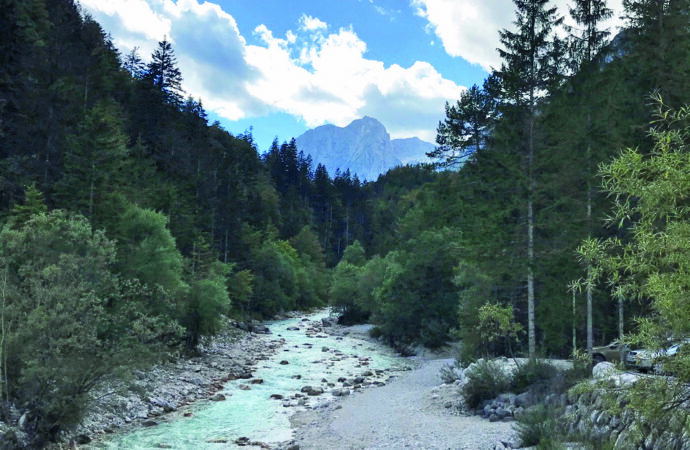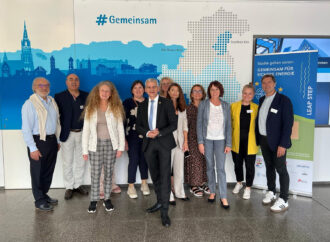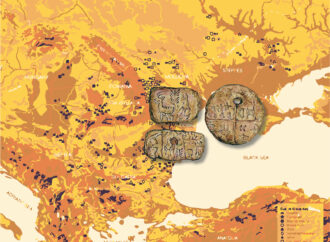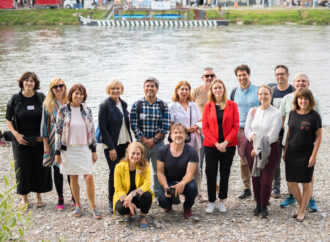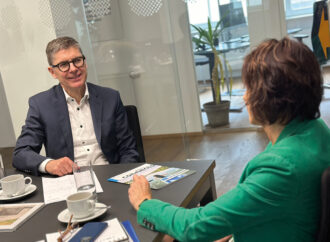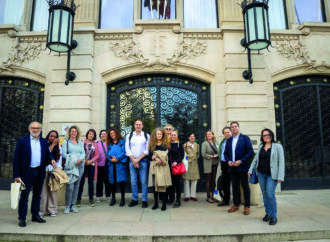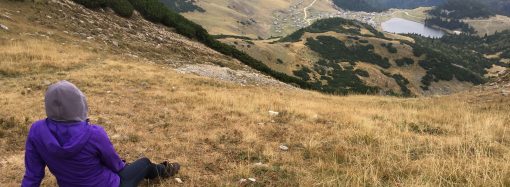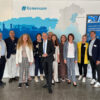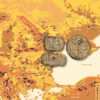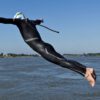My colleague Sabine Geller are on our way to explore Slovenia, one of the “greenest countries in Europe”. Sustainable tourism is very important in this relatively small EU country with its 20.000 km2 and about two million inhabitants. We want our road trip from Ulm to be sustainable. We start our trip in Jettingen-Scheppach with
My colleague Sabine Geller are on our way to explore Slovenia, one of the “greenest countries in Europe”. Sustainable tourism is very important in this relatively small EU country with its 20.000 km2 and about two million inhabitants.
We want our road trip from Ulm to be sustainable. We start our trip in Jettingen-Scheppach with a Tesla Model 3 Performance. The electric car is economic- al: It has a range of up to 530 kilometers. I catch sight of the Triglav. Even after so many years, I am impressed by the mountain. Nostalgia overwhelms me as I see the three mighty peaks in front of me. My parents came from Yugoslavia and every year we went to visit our family during the holidays. Triglav, the highest peak in Slovenia and the Julian Alps at 2864 meters, was our sign that we would soon be “home”. Slovenia is small, but off ers all sorts of recreation. Sea, mountains, fl at land – the- re is something for every character. Cuisine and culture are not neglected either.
Our first destination: the coastal town of Piran in Istria. The town with its lighthouse is considered one of the most beautiful tourist destinations in Europe. The name comes from the Greek word pyros, which means fire. According to the legend, in ancient times a fire was lit on the spot where the lighthouse stands today as a signpost for sailors. The old town also boasts charming Venetian buildings. Italian names indicate how close Italy is. The main square Piazza Tartini is dedicated to the famous composer Giuseppe Tartini (1692 – 1770), who was born here. His father was director of the salt mills in Piran.
Rich through white gold
Salt – that is the white gold with which Piran became rich. To this day salt is still scooped by hand in Secovlje at the foot of the Piran. “Salt of Europe, salt of mother earth. It is our history of the Middle Ages. You cannot buy the salt rights, only lease them. My family history is also connected with it. It was the reason for Piran’s prosperity,” explains Martina Gamboz, project manager of “Piran 2025”, “There used to be other salt flats in Trieste and Koper, but they were mined. Piran salt is extremely white because of its purity compared to other salts. Microorganisms make it so valuable and extremely healthy”. We visit the salt flats of Secovlje. It is raining and it is relatively cool. In front of us there is a wide fi eld, divided into rectangles. Since the 14th century, sea salt has been collected here in a special way. The so-called petola, an artifi cially cultivated soil layer consisting of bacteria, gypsum, carbonate materials and clay, ensures the purity of the salt. It prevents the salt from mixing with the underlying sea mud. The biological fil ter also enriches the salt with its minerals, which makes it so valuable. Even today, the salt is still produced by hand according to an old tradition.
World-renowned olive oil
The Slovenian part of Istria also off ers other culinary highlights – and has done so since ancient times. Above all, the green liquid gold of the peninsula is still sought after worldwide. What makes it diff erent from other olive oils? Its taste is more intense, tart and spicy. “This taste indicates high levels of biophenols and polyphenols, valuable antioxidants”, as Nina explains to us in detail during the tasting. We are at the Froggatt family’s organic farm in the hills of Portoroz. Nina, who now runs the farm together with her British husband, comes towards us beaming with joy. For only 25 €, you can taste olive oil, other olive products and wine. The table in the sales room is beautifully set – figs, tomatoes, mozzarella, pickled olives. We manage to get hold of the last bottles of olive oil with lemon juice and the last two glasses of pickled olives in salt water. From the farm there is a wonderful view of the salt flats. And there’s an intense herbal smell in the air! No matter where you look, bushes of rosemary, thyme and other wild herbs grow from the fertile earth and shape the Mediterranean landscape in the northernmost part of southern Europe. It is time to say goodbye. We continue our journey to Ljubljana, the capital of Slovenia. The infrastructure is excellent in the country. We quietly rush along the smooth road towards the dramatic sunset. The colours in the sky change from light blue to deep orange-red. It is night when we arrive at the B&B City Hotel. A Tesla charging station is already waiting for me. The cosy rooms in the green urban hotel in the centre of the city are furnished with natural materials. On the table, there is a glass with Slovenian forest honey as a gift. It is from the hotel’s own bees that live on the roof of the hotel. The city bees feel comfortable because they are touchingly taken care of. The roof is also the highest point of a bee farm in Slovenia. Forest honey? How can that be? We are right in the middle of the city centre! That’s the wonderful thing about Slovenia and also Ljubljana.
In the Bio-Hotel Trnulja on the southern outskirts of Ljubljana it is like being in another world and another time. The area lies directly in the Ljubljana moor in the middle of pure nature. The old wooden house is steeped in history, you can feel that when you arrive. We unlock the door of the house. The first thing that I see absolutely thrills me! A replica of the Kolo Wheel 5200 hangs on the wall – the oldest wheel in human history with an axle! The sensational find occurred unexpectedly in 2002, when archaeologists took a wood sample in a drainage ditch of the approximately 5200-year-old pile-dwelling Stare Gmanje in the Ljubljana bog near Vrhnika, about 20 km from Ljubljana. The pendant of my room key is also a Kolo Wheel!
5200 years of history
Ursa and Micha, husband and wife and owners of the hotel, smile when they can’t stop my endless enthusiasm. Micha thinks about it and makes a phone call. “I just got off the phone with the friend who found the wheel in his field back then. If you want to, we can go there.” I am as excited as a little child! I’ll get to see the place where one of the most important inventions of mankind was found! The trip there is already an experience. We pass old villages and the nature is very pristine. We stop on the banks of the Ljubljanica river with its sometimes blue and some- times murky waters, which fl ows past us at a leisurely pace. It is so very quiet. I wonder what else remains underneath us from the pile dwellings that date back to the Neolithic period? Micha shrugs his shoulders: “Surely there is still a lot!” We drive up to the fi eld, the site of the sensational fi nd. Not a soul is there. The sun shines on the bales of straw scattered over the field. We hear nothing but the cows mooing on the adjacent pasture. Micha opens a photo on his cell phone. “Look, it was found here.” He compares the current nature with the photo and navigates me to the spot. “A little to the right and a few steps back. Yes, exactly … And a little bit more towards the ditch … Yes! That should be it according to the po- sition of the trees in the background!” He joins me enthusiastically: “I could get used to working days like this!” Absorbed in thought, we stand next to each other and stare reverently at the ground. 5200 years of history in one place – that’s quite humbling! We calm- ly drive back to the hotel, which has a wonderful history.
Ursa, actually an economist, who studied in Vienna and therefore speaks German perfectly, and her husband Micha, originally from the IT industry, discovered this old house completely surrounded by blackthorn as their own private accommodation. “It looked like Sleeping Beauty in deep sleep!” They renovated it following the example of the oldest house in the set- tlement, using natural materials such as wood, clay plaster and hemp insulation. And they turned it into an organic farm. The apartments are large, cosy and absolutely comfortable. The breakfast is a blast! Everything is organic, regional and seasonal. “We barter with our farmers in the neighbourhood. Just like in the days of the pile dwellers”, Ursa explains. We love the goat salami, the warm onion cake with curry sauce, the homemade spreads, the hemp muesli made of home-grown ingredients. Hemp plays a very important role in the family. They were the fi rst who were allowed to grow hemp. Today, they turn it into valuable and healthy cold-pressed oil and muesli. They also propose cooking courses around hemp. And the guest sleeps on hemp mattres- ses. In addition, they grow different kinds of grain and they have almond trees. Today it is one of the five best organic hotels in the country. “Our standard is to be the best!” We immediately believe Ursa. In the evening a late summer dinner is served. Three attractive musicians play traditional melodies. It is time to say goodbye to Slovenia. The next morning we leave the hotel with a weeping eye. Ursa hands each of us a paper bag. It contains delicacies from their farm. And then they have a surprise for me. A key ring in the shape of the Kolo Wheel! We have a hard time saying goodbye – to the farm as well as to the dear owners with whom we felt at home.
Alpine Museum in Mojstrana
We now head back to Germany. I again see the Triglav. Those were always the sad moments in my childhood. From this side the peaks look just as beauti- ful, but they were an announcement that I have to say goodbye to Yugoslavia again for a while. Before that we will make a stopover at the Slovenian Alpine Museum in the village of Mojstrana on the Slovenian-Austrian border. The Mountaineering Museum presents the Slovenian heritage of mountaineering and various topics about the protection of nature in the Slovenian mountains. And the first rescue helicopter of Yugoslavia hangs from the ceiling. The absolute high-light: putting on 3D glasses to float to the heights around the Triglav mountains or to travel to the infinite depths in one of Slovenia’s many caves. “And of course, while you are here, you mustn’t miss a short trip to Triglav!” Sasa, staff member of the museum, leads us to a platform from which you can feel the full beauty of Triglav up close. As we pass the last tree, a dry riverbed runs beside us, surrounded by the imposing steep rock faces of the Triglav. I have never been so close to them. They radiate strength. From here to the top it takes about six hours of walking. We don’t have that much time. But I know I will come back. “I feel Slovenia” – the green EU country could not have chosen a more fitting slogan.
Mirella Sidro,
journalist, Augsburg


